Good Horse Feed for Easy Keepers in Winter
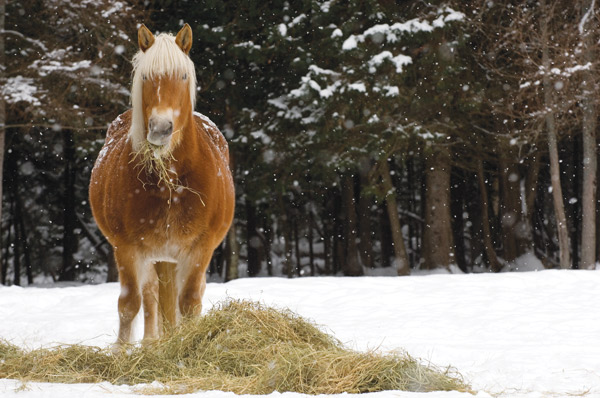
As winter months creep up on us, shorter days and cooler temperatures signal plants to slow and eventually stop their growth. The lush green of your pasture begins to turn to brown. This means less forage is available for grazing horses during the winter, and what is present lacks the nutrition found in warmer months. So how do you transition a horse from moist green grass to dry hay?
Where to Start
Roughage is an essential ingredient for healthy digestion. Spring and summer bring great opportunities for horses to indulge in green pasture, as they graze periodically throughout the day during turnout. But as grass stops growing and browns, a horse likely needs other forage sources, and possibly a complete feed or grain-type supplement.
Besides pasture, typical roughage sources include hay or complete feed pellets. Alternative fiber sources are available, such as soybean hulls, beet pulp, rice hulls, corn cobs, chaff, and straw, but these don't allow horses to "graze" on something all day long.
Instead of being fed two to three relatively large meals in a 24-hour period, it is better for a horse to have the opportunity to nibble periodically throughout the day and night. In general, horses fed large amounts in two meals a day tend to bolt the food in a short time—an hour or two at most. This results in long fasting periods until the next meal arrives, possibly leading to ulcers or behavioral vices. This is not at all how the equine digestive system is supposed to work.
To keep your horse healthy and thriving, it's best to feed him a minimum of 1½ to 2 percent of his body weight in roughage (hay or pasture) each day. Active equine athletes may need at least that much hay plus a grain-type supplement and/or a high-fat supplement, like vegetable oil or rice bran.
Horse Dental Care
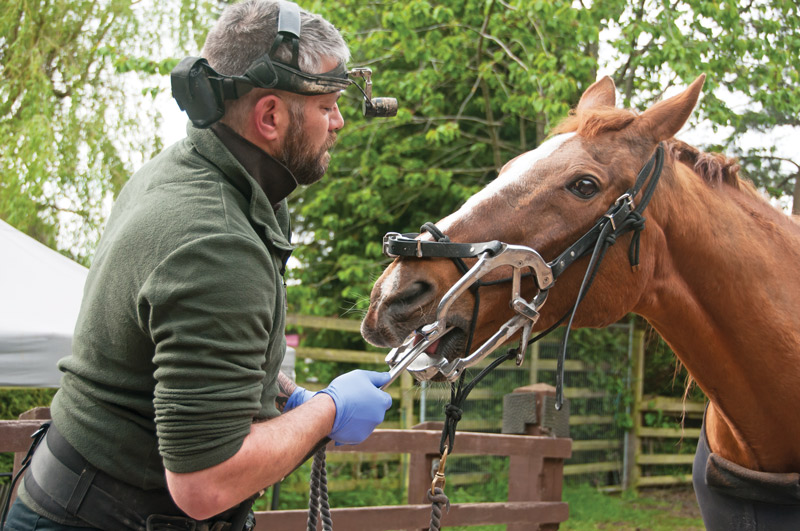
Dry hay is considerably more difficult to chew than fresh grass. This means that attention to details, like dental care, becomes important, not only so horses can extract the most nutrients from their diet, but also to minimize the risk of impaction colic or irritant diarrhea from food that isn't chewed well.
Have your veterinarian perform a thorough dental exam at least once a year, especially heading into the winter months. Sharp points can be removed through floating procedures, so your horse is more comfortable chewing and can break down hay stems. This improves digestibility of the forage.
Senior horses often need especially diligent dental care to be able to extract the most from their hay. Some are missing so many teeth that it may be necessary to offer a gruel of soaked complete-feed pellets.
Additional calories can also be added by way of soaked beet pulp pellets, which are high in fiber and provide added safe calories for a more difficult keeper.
Slow that Gluttonous Horse Down During Winter
Ideally, a horse offered free-choice hay would control his intake, eating only as much as he needs to maintain the perfect body condition. But some individuals won't stop eating, and—like with people—excesses calorie intake results in obesity.
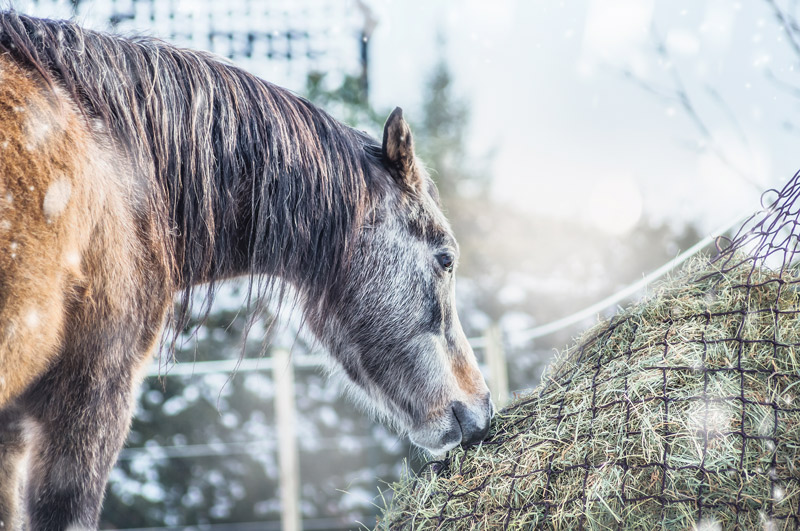
Feed intake by voracious eaters and easy keepers can be slowed by using a slow feeder. These feeding systems are made of either a container that is hung on the wall or a box or frame feeding system on the ground. Close-knit grids or small holes in the feeder forces a horse to work at getting hay out. Many commercial small-hole hay nets are also available with 1½- to 2-inch holes, but some crafty ponies may need 1¼-inch or even 1-inch holes.
Read More: Nutrition for the Easy Keeper
Compared to throwing loose flakes of hay on the ground or in a stall, it takes a bit more effort and time for a horse to pull out hay from a slow feeder. This more closely approximates grazing, and it shortens the fasting periods between refills, keeping your horse's stomach and intestines in a healthier state. To add to the benefits, there is less wastage caused by a horse trampling or soiling his hay, which then keeps feed expenses down.
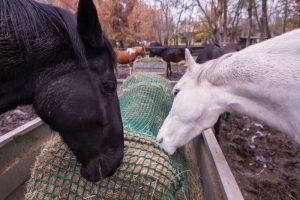
For horses in a large dry lot turnout, an alternative is to use a mesh sleeve that fits around a large bale of hay. (Horses should be barefoot if using these to avoid getting a shoe tangled up.) "Double bagging" the hay bale in a net feeder further reduces the mesh size and makes it more challenging to extract hay.
Some horses figure out how to maximize how much they can pull from the holes, and will need the slow feeder bag hung from stall rafters on a breakaway rope to prevent the horse from bracing it against a firm surface and speeding up his eating.
Supplemental Nutrients During Winter
A ration balancer is a good supplement to provide for horses transitioning from pasture to hay. These are vitamin/mineral pellets fed from a large bag generally at 1 to 2 pounds per day and are great if your horse doesn't need extra calories from grain. Consult with your veterinarian about the ration balancer most appropriate to your area.
Vitamin E is a key nutritional ingredient for all horses. Inadequate intake of vitamin E can cause muscle, neurologic, or immune system problems, and at the very least may affect performance. This vitamin may be deficient for horses that have no access to green grass, as it tends to dissipate as hay is dried after cutting and baling.
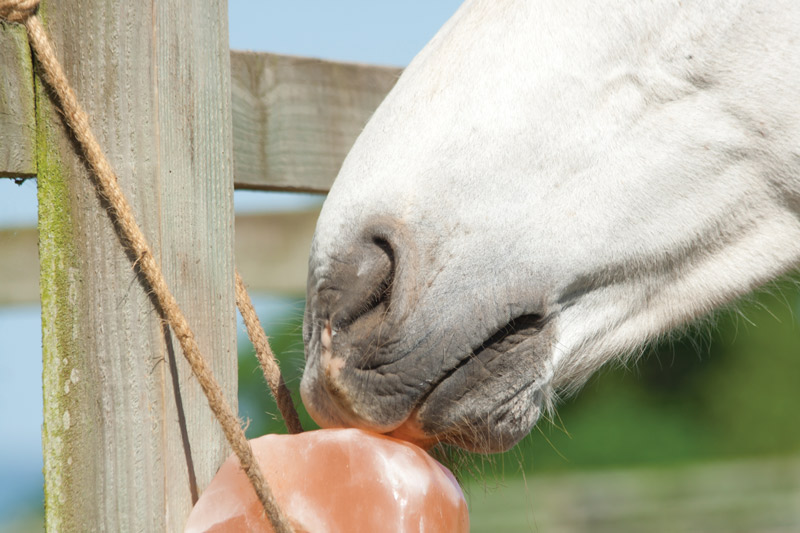
A Canadian study demonstrated that horses with pasture access in summer months had vitamin E plasma concentrations that were 63 percent higher than non-pastured horses that consumed only hay or pelleted feed. This is a particular concern for young, growing horses as well as adult and athletic horses.
In addition, horses that are supplemented with high-fat diets to improve calorie intake may be deficient in vitamin E if it is not supplemented as an antioxidant along with the fat. The best vitamin E supplement to use is d-alpha-tocopherol, a natural vitamin E that is readily absorbed.
Vitamin A or carotene may not be present in adequate amounts if horses are fed older batches of hay or hay that has lost its green color. Most commercial feeds contain ample vitamin A, so feeding small amounts of pelleted feed is likely to provide a sufficient supply of vitamin A.
An insatiable desire for fiber may cause horses with limited pasture or forage access to consume the dirt or bedding around them. This has the potential to lead to sand colic or impaction colic. Use of psyllium fiber fed for six or seven consecutive days each month helps clear the intestines of ingested sand and dirt.
Intake of sand and dirt can be prevented in the first place with feeding systems that limit access to dirt, such as rubber mats, or by using the slow-feeder method.
Salt is an important dietary ingredient for any horse. Provide a salt block that your horse can access voluntarily. This is safer than adding salt to the feed, as any excess salt is simply urinated away, making more work for the kidneys.
In some areas of the country, the soil may be low in selenium, leading to a deficiency in the hay. Check with your veterinarian before supplementing with selenium, as over-supplementation can cause serious problems from toxicity.
And finally, don't forget to provide plenty of clean, unfrozen water to your horse in the winter. Water is considered an important nutrient for digestion, preventing the dry, fibrous feeds from becoming impacted in the intestines and keeping all metabolic processes running as they should. If your water tends to freeze, plug-in buckets or tank heaters designed to safely warm the water are your best bet.
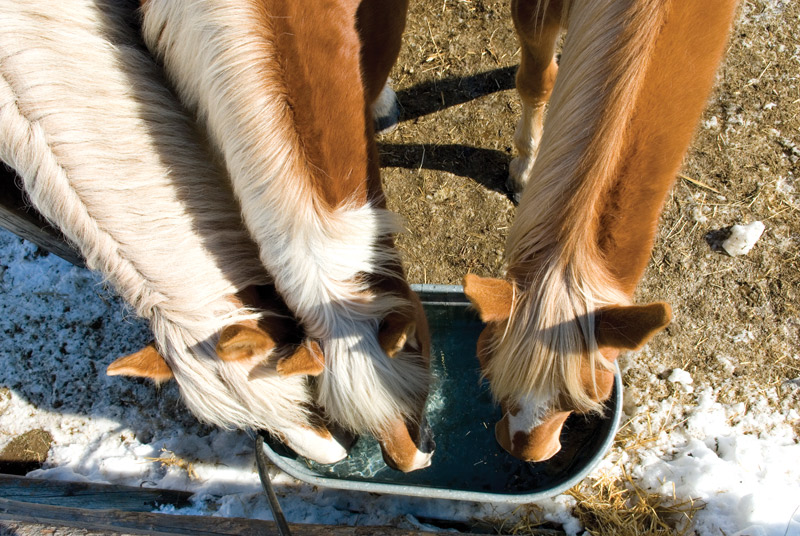
Boosting Your Horse's Nutrition During Winter
With some common sense and creativity, you can find ways for horses in winter months to acquire their feed more in keeping with natural trickle-feeding tendencies to optimize gut health. The ability to eat small, intermittent meals throughout the day also works wonders on a horse's mental health and behavior.
This article about winter nutrition for your horse appeared in the November/December 2020 issue ofHorse Illustrated magazine. Click here to subscribe!
lovelaceforga2002.blogspot.com
Source: https://www.horseillustrated.com/winter-nutrition-for-your-horse
0 Response to "Good Horse Feed for Easy Keepers in Winter"
Отправить комментарий